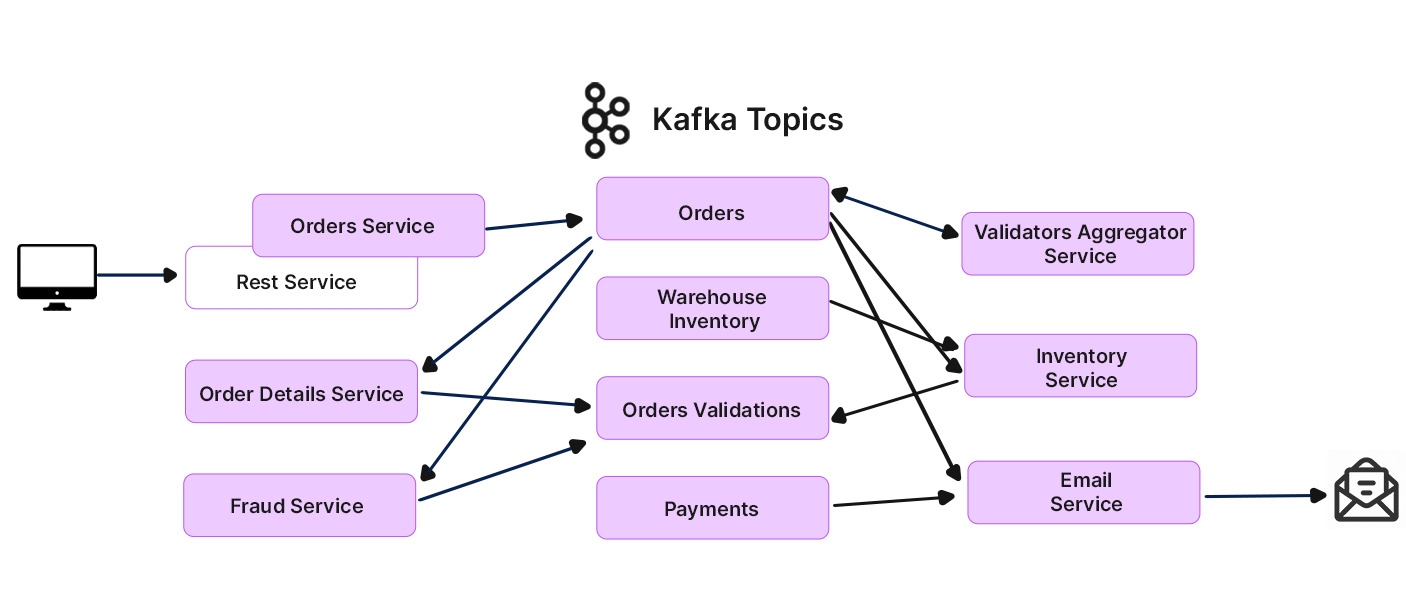Microservices architecture has not only revolutionized the software design approach but also succeeded in enhancing agility and scalability. It breaks down applications into smaller, independent services.
However, seamless communication and scalable coordination pose in this decentralized setup. Apache Kafka plays an essential role as it is a robust distributed event streaming platform. Leveraging Kafka Integration Java Microservices, it acts as a communication backbone, allowing real-time data exchange among microservices.
Here in this image, you can see how microservices communicate through Apache Kafka with production issues in your inventory services.

Here in this blog, we will discuss how can you unlock scalability and flexibility in Java Microservices with Apache Kafka
Let us understand the common challenges faced:
Microservices: Communication Challenges
Tight Coupling :
- Microservices often suffer from tight coupling while being independent.
- Direct dependencies between services can hinder development speed and increase maintenance complexities.
Scalability Concerns :
- The scalability of individual microservices becomes a challenge when communication protocols lack robustness.
- Scaling one service without affecting others requires careful design.
Single Point of Failure :
- In a microservices setup, the failure of one service can cascade across the system, impacting overall reliability.
- Managing and mitigating these failures is crucial for a resilient architecture.
Existing Communication Methods
Synchronous APIs :
- Common communication methods involve synchronous APIs, but they come with limitations.
- Real-time communication and scaling become intricate, often leading to performance bottlenecks.
Addressing Challenges with Kafka Integration
Kafka Java API Integration :
- Leveraging Kafka’s Java API, microservices gain a reliable and asynchronous communication channel.
- This integration promotes decoupling, easing the tight dependencies seen in traditional setups.
Java Spring Kafka Integration :
- Integrating Kafka with Java Spring further streamlines communication.
- Spring Kafka facilitates seamless interactions, enhancing the overall efficiency and responsiveness of microservices.
Kafka Microservices Integration :
- The architecture of Kafka inherently supports microservices.
- By embracing Kafka for inter-service communication, scalability concerns diminish, and the system becomes more resilient to failures.
Java Kafka Integration :
- The integration of Java with Kafka provides a powerful solution.
- The versatility of Java combined with event-driven capabilities fosters a communication paradigm that is both robust and scalable.
Kafka to the Rescue: Event-Driven Communication
Event-Driven Architecture (EDA) in Microservices :
Embracing Event-Driven Architecture (EDA) in microservices brings a paradigm shift. Events, as communication triggers, foster loose coupling, resilience, and scalable systems. Microservices gain independence by communicating through events, handling failures autonomously, and scaling without impacting communication.
Kafka’s Role in EDA :
Apache Kafka stands out as a robust facilitator of Event-Driven Architecture. Its features empower microservices in an EDA environment:
Producers :
Microservices act as producers, publishing events/messages to Kafka topics, and initiating seamless communication.
Consumers :
Microservices become consumers, subscribing to relevant topics and asynchronously consuming messages, ensuring real-time responsiveness.
Brokers :
Kafka brokers efficiently manage message storage and delivery, orchestrating the flow across the network.
Integrating Kafka with Java Microservices
Implementing Kafka Integration Patterns in Java Microservices involves:
Adding Dependencies :
Integrate Kafka into Java microservices by adding necessary dependencies to the project, establishing a foundational link.
Producer and Consumer Setup :
Utilize Kafka Producer API and Kafka Consumer API to create producers and consumers, respectively. Code examples can showcase the simplicity of initiating communication.
Message Handling :
Microservices can publish and consume messages to/from Kafka topics, showcasing the versatility of real-time data processing with Kafka in Java microservices.
Kafka Integration Patterns in Java Microservices enable real-time data processing and streamline communication. This not only enhances the efficiency of individual services but also contributes to the overall scalability and resilience of microservice architecture.
Kafka Stream Processing in Java Microservices Architecture becomes a cornerstone in achieving event-driven communication excellence.
Benefits of Kafka in Java Microservices
Improved Scalability and Flexibility :
- Java microservices integrated with Kafka benefit from its horizontal scalability. Each microservice can scale independently.
- It ensures flexibility in managing varying workloads.
Increased Resilience and Fault Tolerance :
- The distributed architecture of Kafka enhances the resilience of microservices.
- Asynchronous communication and fault tolerance mechanisms allow services to handle failures independently, contributing to a robust and fault-tolerant system.
Decoupled Communication and Faster Development Cycles :
- Kafka facilitates decoupled communication between microservices.
- This independence accelerates development cycles, as services can evolve without disrupting the entire architecture.
- Java Spring Kafka integration further streamlines development, enhancing agility.
Real-World Use Cases of Kafka in Microservices
Order Processing and Fulfillment Systems :
- Kafka ensures seamless communication between various components in order processing systems.
- Events related to order updates, inventory changes, and shipment notifications can be efficiently processed, enhancing the overall responsiveness of the system.
Real-Time Analytics and Event Processing :
- Java Kafka Integration is pivotal in real-time analytics.
- Microservices can publish and consume events related to user activities, enabling instantaneous processing for personalized recommendations, trend analysis, and other data-driven insights.
Social Media Platforms and Messaging Applications :
- Social media platforms leverage Kafka for real-time updates and notifications.
- By integrating Kafka with Java microservices, messaging applications can provide instantaneous message delivery and notifications, ensuring a smooth user experience.
Conclusion
Harnessing the power of Apache Kafka in Java microservices brings unparalleled scalability and flexibility to modern architectures. Kafka can help you with seamless communication, fault tolerance, and real-time data streaming.
You can turn to Ksolves for any guidance and tailored solutions. Our proven expertise and innovative approaches make them a go-to partner. We are experts in providing solutions for a variety of Apache Kafka use cases.
Want to unlock the full potential of the Kafka Integration with Java Microservices? The best Apache Kafka Development Company is a click away.
Hope this was helpful!
AUTHOR
Share with